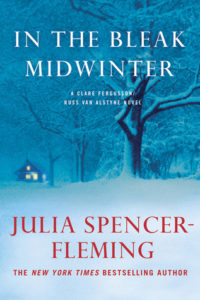From the bespectacled Father Brown, blundering along with pipe and umbrella, to Clare Fergusson, the tenacious, Air-Force-pilot-turned-Episcopal-priest, the clerical detective delights mystery fans with the twining of murder and mysticism, death and divinity. Why does the priest, minister, rabbi or nun make such a compelling and fascinating detective? Because religious types are natural sleuths in their own right as they sort out the most troublesome realities of society: order and chaos, good and evil, right and wrong. Not unlike the police detective or the gumshoe private eye, the members of the clergy are often faced with the dark side of humanity. But unlike their more mainstream contemporaries, they temper it with an enduring faith in goodness. Throw in the melodrama of a church jumble sale, the social entanglements of a lady’s luncheon, or the tension of parish council meeting, and you have the perfect setting for murder.
This list focuses on the top ten clerical mysteries found in a series, chosen for their intriguing detectives and page-turning plots as well as an acquaintance with all things ecclesial. An ecclesial mystery must, above all, represent the faith community with authenticity: the good, the bad and the ugly, from last rites to first communion.
One final note, the list is as ecumenical as I could get it: Protestant, Catholic, Jewish, and one Protestant sect, the Shakers. I searched for an Imam detective, but as yet, haven’t found one.
Julia Spencer-Fleming, In the Bleak Midwinter
(A Clare Fergusson Mystery)
This riveting story by Julia Spencer-Fleming gives the reader the good feeling of a cozy complete with an Episcopal priest, a small town, and a somewhat handsome police chief to spark a bit of romance. But then, Fleming pulls the cozy rug out from under the reader when the priest/sleuth stumbles across a brutally murdered woman. This same woman had just dumped (albeit, gently) her newborn baby outside St. Alban’s—the church of the newly ordained Clare Fergusson, Spencer-Fleming’s amateur sleuth. Clare, an ordained priest, is certainly not Father Brown, but rather, an army pilot-gone-to-seminary. Many women who go into the parish as ordained clergy are second-career—always taking the skills learned in that career into the work of the church. Spencer-Fleming, in her character Clare Fergusson, demonstrates this reality and exemplifies the richness a second-career priest can bring to the parish– even if the first career had been a fighter pilot.
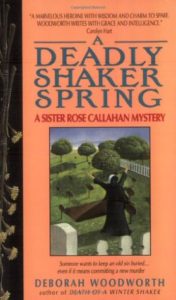
Deborah Woodworth, A Deadly Shaker Spring
(Sister Rose Callahan Mystery)
One thing to especially enjoy about this series by Deborah Woodworth is its historical accuracy. The author, Deborah Woodworth has a Ph.D. in the Sociology of Religion and grew up in southern Ohio near the historical site of several Shaker communities—a background which informs and colors her descriptions of the Shaker world. Woodworth effortlessly introduces the reader to Shaker history and culture making the book an intriguing lesson in history as well as an exciting murder mystery. Sister Rose is a sharp, perceptive sleuth who fights for her own identity in the very male world of the 1930’s. She comes out the winner though, and this first mystery wins as well.
Ellis Peters, A Morbid Taste for Bones
(The Chronicles of Brother Cadfael)
Brother Cadfael is the best kind of clerical sleuth—intelligent, funny, a bit worldly and yet, humble enough to be engaging. Like any monastery worth its salt, the one in this book wants some bones of a saint. Just about any saint will do, but St. Winifred in North Wales is decided upon, and the expedition to retrieve her bones, commences. All sorts of troubles befall the group from the monastery, not the least of which is the pesky fact that the church in Wales doesn’t want to release them. A wealthy villager ends up dead, and the search for whodunnit commences. The plot is filled with false leads that take Brother Cadfael in all directions, but in the end, he achieves a satisfying resolution for the reader. An excellent crime read full of twists and turns, humor and poignancy.
Harry Kemelman, Friday the Rabbi Slept Late
(The Rabbi Small Mysteries)
It was once said that author Harry Kemelman ”was to rabbis what G. K. Chesterton was to priests.” Like any good clerical detective, Rabbi David Small uses his trade, in this case, Talmudic logic, to accomplish his sleuthing. In Friday the Rabbi Slept Late, the police discover a young woman’s body outside the temple, but her handbag is in Rabbi Small’s car. And although that fact alone is unfortunate enough for Rabbi Small, the stakes are even higher for him since his contract with the synagogue is up for consideration. Scholarly and ponderous, some members have entertained second thoughts about his hiring him as their rabbi. Now with a suspicious murder hanging over his head, the rush was on for Rabbi Small to uncover the killer or risk losing his professional position. Author Harry Kemelman offers the two elements that all mystery readers want—fascinating characters and intricate plot. But at the same time, he uses his familiarity with the Talmud to interest the most intellectual of readers.
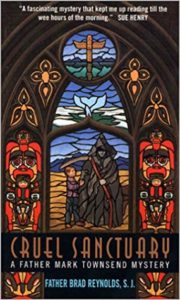
Brad Reynolds, Cruel Sanctuary
(A Father Mark Townsend Mystery)
A mysterious visitor hides in St. Joseph church at night. Father Townsend, confident that it is a young person, homeless and in need of assistance, leaves a note and cash. In his notes, he asks that the recipient come and see him. The next thing he knows, the police ar at his door.
A young teen, a boy only fourteen, has been found dead in the park nearby—with the note and money from the priest on him. To help the family of the boy and to salvage his own reputation, Father Townsend begins to investigate. However, he begins to neglect his pastoral duties and his congregation revolts. All of that means, Father Townsend needs to solve the case.
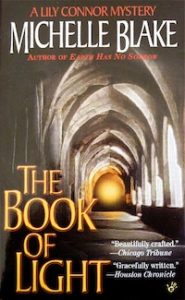
Michelle Blake, The Book of Light
(A Lily Connor Mystery)
Lily Connor, an Episcopal priest in Boston, is everything one wants in both a good detective and in a good priest. She is talented, rational, vulnerable, and compassionate—an essential mix of characteristics in both a priest and an amateur sleuth. The Reverend Lily Connor, the interim chaplain at Tate University in Boston, is asked for help by an old seminary friend named Samantha. Samantha has been receiving evidence of an ancient scroll known as the Book of Light. The Book of Light had the transcribed words of Jesus. A dangerously valuable manuscript, Lily’s investigation becomes dangerous as well. Author Michelle Blake, schooled in the academic study of religion though not ordained, brings authenticity and richness to the character of her detective, Lily Connor. Scholarship and intellectual integrity abound in this clerical mystery.
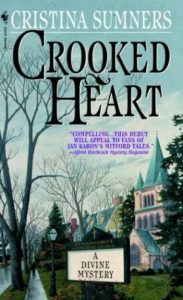
Cristina Sumners, Crooked Heart
(A Divine Mystery)
In this first novel by author Cristina Sumners, the amateur sleuth is an Episcopal priest (why are they all Episcopalian—what happened to the Methodists or the Lutherans?), the Reverend Kathryn Koerney. She is the pastor of a small church in a New Jersey college town (a lot like Princeton). Kathryn is a Lord Peter Wimsey fan and brings to life some of his quirks which add to the enjoyment of the book. Her side-kick, a police officer named Tom Holder, also happens to be on the church vestry. A wealthy woman in the community goes missing, and Tom eagerly enlists Pastor Kathryn’s help. Soon another woman disappears and not surprisingly, as Tom and Kathryn solve the mystery, they also fall in love.
Peter Tremayne, Absolution by Murder
(A Sister Fidelma Mystery)
From Absolution by Murder (1994) to Bloodmoon (2018) this series had held the interest of mystery readers for the past quarter of a century. Tremayne presents the reader with a winning combination—the convincing character of Sister Fidelma matched by the fascinating depictions of 7th century Ireland. Sister Fidelma, an Irish nun at St. Brigid’s Abbey is possibly the most interesting—and smartest—nun ever to be found on the pages of a clerical mystery. A “religieuse” as she is called throughout the series, she also trained as an advocate of Irish law called the Brehon law system. Both heroine and detective, amateur and professional, Sister Fidelma never fails to captivate the reader.
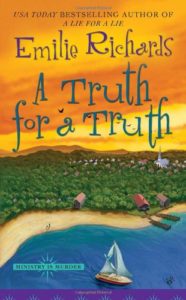
Emilie Richards, A Truth for a Truth
(A Ministry is Murder Mystery)
This book isn’t precisely a clerical mystery in that the amateur sleuth is the wife of the minister and so, I began reading with less than enthusiasm. Within a few pages, however, I was hooked. The sleuth, Aggie Sloan-Wilcox, is funny, resourceful, and clever. But the aspect of the book that I loved was that author Emilie Richards perfectly nails life in a clergy couple and the experience of the spouse of a pastor. In this story, the former minister of the church returns to Emerald Springs and dies almost immediately. Aggie’s minister-husband is about to do the funeral when the call comes from the funeral director that the body would be taken to the coroner instead. The previous minister had been murdered. Richards brings her own experience as a minister’s wife to good effect in this funny, fast-paced mystery.
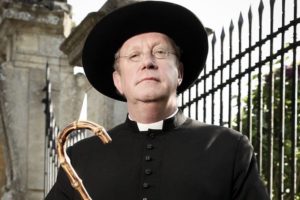
G.K. Chesterton, The Innocence of Father Brown
(The Father Brown Series)
The Innocence of Father Brown, by G.K. Chesterton, is not so much a novel, as it is a collection of eleven stories about the detective. I have included it in this list because it is the birthright of the clerical mystery. All clerical mystery writers owe a little something to G.K. Chesterton much in the same way that all cozy mystery writers owe Agatha Christie. In his series, Chesterton points out the ambiguities and absurdities of Christian ecclesiology while solving murder. The priest-sleuth Father Brown, both bumbling and astute with “a face as round and dull as a Norfolk dumpling,” captivates readers with his endearing qualities and his ability to circumvent the village constable. Father Brown is the parent of all clerical mystery.


